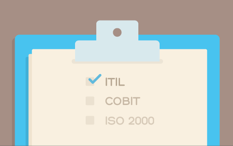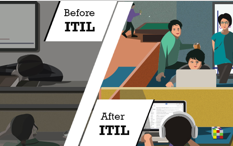Foundation level
This is the first level of certification. It’s focussed on general awareness of the key elements, basics of ITIL concepts, important definitions used in ITIL service lifecycle and their contribution to service management practices.
The foundation level of ITIL certification is aimed at folks
- Who wish to have a basic understanding of ITIL framework
- Who want to gain an understanding into how ITIL could be implemented for bettering IT service management.
The foundation level consists of 40 multiple choice questions and awards 2 credits to candidates who clear the level. A minimum of 65% (26/40) would help you procure a certification. The foundation level is a closed book examination and there are no prerequisites required to take the exam; anyone with an interest in IT service management can take the exam.
Practitioner level
The practitioner level is the second step in ITIL certification. This stage focuses on providing a bridge between the foundation level and intermediate level (third level in ITIL certification). The main aim of the practitioner level is to equip the IT folks with the ability to adopt ITIL frameworks at their workplace.
Building on best practices from other frameworks like DevOps, Agile, Lean, ITIL practitioner adds value to any improvement initiative in IT service management. Like the foundation level, the practitioner level has 40 multiple choice questions to be answered in 135 minutes. A minimum of 70% (28/40) ensures you clear this level. Unlike the first level, this is an open book examination. A completion of this level would award you 3 credits.
Intermediate level
has a flexible structure and includes two categories
- Service lifecycle
which consists of five examinations. The five examinations will cover service strategy, service design, service transition, service operation and continual service improvement.
- Service capability
with four examinations, includes planning protection & optimization, release control & validation, operational support & analysis and service offerings & agreement.
As you would have seen from the above details, each module in the intermediate of ITIL certification focuses on different aspects of service management. You can choose to take as many or as few intermediate qualifications as you wish. Based on what you like to extract from the module, you can mix and match modules from both these categories.
The intermediate level gives you 15 or 16 credits (Based on the modules you choose). However, the intermediate level is only open to people who have successfully completed ITIL foundation exam AND have completed an accredited training course from ITIL accredited organisation.
Expert level
If you’re someone who wants to demonstrate the length and breadth of your understanding of ITIL frameworks, then ITIL expert certification is perfect for you. The expert certification is awarded to people who have a well rounded, in-depth knowledge and skills of ITIL’s best practices.
There are some important requirements for one to take an ITIL expert certification
- The candidate should have appeared for an ITIL foundation or a bridge certification
- The candidate must have earned a minimum of 17 credits from foundation and intermediate course.
- The managing across the lifecycle (MALC) module should have been taken to achieve a total of 22 credits, a minimum qualification to appear for ITIL expert certification
Master level
Every ITIL master candidate will have to demonstrate successful implentation projects in ITIL related work from their workplace. There’s no fixed/prescribed syllabus or training suggested by Axelos- The makers of ITIL frameworks. Axelos website states “you must ensure you have extensive practical 'hands-on' ITIL experience and can demonstrate active involvement in implementation of the practices”... In order to appear for Master level of ITIL certification, one must
- Have cleared ITIL expert certification
- Have worked ITSM for at least 5 years in a leadership, managerial, advisory roles in management.
Managing across lifecycle certification
Awards the candidate with 5 credits. Passing the ITIL foundation exam along with 15 additional credits (from intermediate courses) is a minimum requirement for appearing for this exam. In other words, you need a minimum of 17 credits to take this exam. Many IT folks around the world use this as a gateway to achieve ITIL expert certification.
As you complete each level of certification, you’re awarded with the certification and attributed credits
















